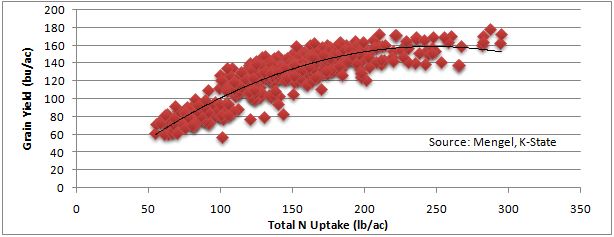Fertilizing Grain Sorghum
By Brent Bean, Ph.D., Sorghum Checkoff Agronomist
The cost of planting grain sorghum is much less expensive than other crops, primarily because of seed price. As a result, many growers assume they can save on other input costs as well. The best example of this involves the use of fertilizer. On a per bushel basis, grain sorghum requires a similar amount of most nutrients as corn. If a grower wants to produce a 100-bushel sorghum crop, the grower must support this yield goal with a supply of adequate nutrients, including phosphorus, nitrogen, sulfur and potassium. In some soils, growers also may need to adjust pH to ensure the availability of soil nutrients to the sorghum.
Soil pH
This critical component determines if nutrients in the soil can be taken up by the plant. Optimum nutrient availability occurs within a pH range of 6.5 to 7.5. When pH drops below 5.6, liming is warranted to reduce soil acidity,which then allows plants to utilize soil nutrients.
Phosphorus
Phosphorus is especially limited when pH drops below 6 or is above 8. When pH falls outside the optimum range, agronomists often recommend applying phosphorus in or close to the seed furrow or in a narrow band a few inches to the side and a couple of inches deep into the soil. By concentrating the phosphorus,the nutrient has less opportunity to become “tied up”by the soil. In addition, common phosphorus fertilizer sources contain nitrogen and sometimes sulfur, which tend to lower the pH within the narrow band to allow greaterphosphorusavailability.Growers should base the amount of phosphorus fertilizer applied on soil test estimates and yield goal.
Nitrogen
In most farming environments,the most limiting nutrient to yield is nitrogen. Sorghum is no exception, requiring 1.12 pounds per bushel of grain produced, which is very similar to the recommendation for corn. As shown in the graph below, yield becomes less responsive to nitrogen as yield approaches 150 bushels per acre becauseyield becomes limited by other factors. Growers must base the amount of nitrogen applied on factors including yield goal, the amount of residual nitrogen in the soil profile and the expected nitrogen amount mineralized from soil organic matter. Soil sampling and analysis are critical for this determination and will prevent both the overapplication and underapplication of fertilizer.

Going into the growing season, growers often find it difficult to set a yield goal and, in turn,struggle with calculating the proper amount of nitrogen needed. Since growers do not want to overapply nitrogen, they can manage nitrogen with a multiple-application plan. Growers should consider applying no more than 50 percent of the anticipated needed nitrogen as a preplant application and then adjusting the remainder of the nitrogen applied to meet the anticipated yield potential as the season progresses. A multiple-applicationplan is particularly important on sandy soils where preplant nitrogen can leach out of the sorghum root zone following heavy rains.
Once sorghum is established, two critical growth stages occur when lack of nitrogen can significantly impact yield. The first stage occurs approximately 30 days after emergence, when sorghum enters a rapid growth period and the potential number of grain kernels start to form. Adequate nitrogen must be present to support this rapid growth period. The second stage is at or just prior to the boot stage, which occurs approximately one week prior to heading, when nitrogen supports good pollination, grain set and grain fill.
Sulfur
An often neglected nutrient in grain sorghum is sulfur, which improves nitrogen use efficiency and is especially important as yield increases. Growers should strive to keep the nitrogen to sulfur ratio at approximately 15-to-1.
Potassium
In most U.S. soils,potassium is available in adequate supply for the needs of sorghum. However, growers may need to add potassium in very shallow soils with reducedrooting depths and on sandy soils.




